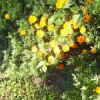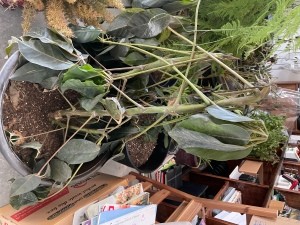I have a 15 year old Scheffelera that was left outside during a hard freeze for a couple of days. I brought the plant inside and the leaves were drooping and brown.
I was advised to cut all the leaves off and trim it back a little. The branches were still green under the bark, but are now turning black. Is there anyway to save this tree? If I cut the branches all the way back can it still survive?
Hardiness Zone: 9a
By suzanne from Mandeville, LA
Add your voice! Click below to answer. ThriftyFun is powered by your wisdom!

Scheffelera
The popular Brassaia actinophylla (schefflera or umbrella tree) has been widely grown for many years in Florida as an indoor foliage plant, while Schefflera arboricola (dwarf schefflera) has been of major importance since the mid 1970s. Other cultivars and varieties have become available during the past ten years with improved disease and pest resistance such as B. actinophylla `Amate'. Additionally, variegated cultivars of dwarf schefflera are constantly being introduced. The 1991 Florida Foliage Locator lists the following cultivars of S. arboricola; `Covette', `Gold Capella', `Jacqueline', `Renate', `Trinette', and `Variegata'. Although these scheffleras are available in virtually any size from 3 to 38 inch pots they are primarily available in 6 to 14 inch pots.
Schefflera arboricola can be from cuttings about 1 inch long below the leaf and taken from below the two uppermost fully developed leaves and above the lower oldest leaves. Seed of S. arboricola stored for 3 weeks at 65, 75, 85 or 95°F had germination percentages of 69, 75, 73 and 35, respectively, 3 weeks after planting compared to 93% germination of seeds planted immediately. Brassaia actinophylla are not generally propagated from cuttings although seeds and tissue cultured plantlets are commonly employed. Seed of B. actinophylla were reported to have a 67% germination when planted immediately.
Both schefflera and dwarf schefflera can be grown in full sun, but most plants are produced in 47 to 55% shade (approximately 5,000 to 7,000 foot-candles). High quality plants can be grown at this light level with a 3-1-2 ratio fertilizer, such as 9-3-6 or 18-6-12 at a rate of 1800 to 2400 lbs N/acre/year (equivalent to 41 to 55 lbs N/1000 square ft-year or 6 grams 19-6-12/6" pot and 10 grams/8" pot-3 months) plus micronutrients. Higher fertilizer levels will be necessary to produce plants of good quality if higher light levels are provided, but plants will not be acclimatized for interior conditions.
Good quality S. arboricola have been found to contain 2.8-3.7% dry weight N, 0.26-0.35% P, 2.5-3.5% K, 1.5-2.0% Ca and 0.4-1.0% Mg and good quality B. actinophylla contained 2.0-4.5% N, 0.15-0.50% P, 2.0-3.5% K, 0.5-1.8% Ca and 0.3-0.7% Mg. Good quality B. actinophylla was grown in a range of 2.5 to 10.2 mhos/cm when under 70 ft-c and 100-150 mhos x 10-5 when grown under 1200 ft-c.
Potting media used for schefflera must have good aeration, especially if plants are grown where they are subjected to rainfall, since root loss may be extensive during rainy periods when soil oxygen levels are low. Schefflera will tolerate 35 to 105°F without chilling or heat damage, but best growth and quality occur between 65 and 90°F. Schefflera `Gold Capello' was reported to bring greatest returns when grown at a minimum temperature of 60°F as opposed to 64 or 68 in Belgium during the winter. Brassaia actinophylla had less symptoms of Alternaria leaf spot when grown at a minimum night temperature of 75°F than at 60 and almost no symptoms when grown continuously at 80°F. S. arboricola grew taller and had better color when produced in 85% relative humidity compared to 60% relative humidity. B. actinophylla is very susceptible to ethylene. Both species can be shipped at 50-55°F for 4 weeks with slight loss of quality. Growth of S. arboricola was equal when grown indoors under fluorescent or incandescent light at equal intensities. Good luck.
in Florida, my wild schefflera arboricola froze outdoors in January. when and how do I prune it.

Too often people throw out a damaged plant when there is still life in those sad stems - kudos to you for wanting to save yours. In fact, anything below 40 degrees for longer than a day will damage most potted tropical plants, so in the Southern Coasts region, it's wise to have a place indoors or on a protected porch to put the plants during cold weather. If the tops of the schefflera stems have wilted from cold and not revived, cut them off and put the plant where it will not be subject to freezing temperatures again so it can recover.
The result may be misshapen, and it is a good idea to prune the unaffected stems too, so the new growth will be produce well-shaped plant. Should the damage be more severe, and the entire plant looks ruined, don't give up until after you cut all the dead stems back, even to the top of the container. Although it looks like a goner, the roots may be alive and capable of sending up new stems. While the plant is in this distressed situation, be careful not to overwater, and use fertilizer sparingly if at all. Good luck.
I have cut my schefflera back a few times Suzanne and it has grown OK. The most recent time I air layered the plant and made two plants from the one as it became very leggy (spindley). Here are some pics of my air-layering if you would like to see them.
s713.photobucket.com/
Richard
Did your plant survive? I have the same situation in the recent Texas winter freeze.... I am so sad. I hope mine live. I have brought it inside in a sunny room.

I left my plant out and it froze. I live in Texas. How do I revive it
Frozen plants often don't make it. I would bring it into a warmer place and cut off any leaves that have been damaged. Hopefully, new growth will come up but it will take time.
Good luck, hope it is just stunned by the cold weather and not entirely frozen.
What to do when ur scheffelera has been outside for years n u cover them up cause of a freeze.... Now not sure when to prune the ?
Spray it with copper fungicide, cut off all necrotic freeze damaged areas, the most important factor in determining how damaged it is will be how badly the roots were damaged, if you can cut off any necrotic tissue, roots included and then try and seal the cut wounds above ground with a wound seal and brush rooting hormone on the cuts of any damaged root areas that you removed it has a chance of survival.
Add your voice! Click below to answer. ThriftyFun is powered by your wisdom!